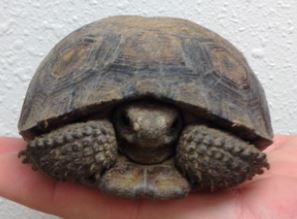Healthy desert tortoises hibernate during the cool winter months. These herbivores spend the winter deep in their burrows away from the chilly desert nights. Tortoises kept as pets in places out of their normal range brumate in boxes kept in a cool place. The term brumate means artificial hibernation. Here are my tips for getting tortoises ready for their big nap:
- Veterinary Examination-Before allowing a tortoise to hibernate/brumate, they should be examined by a veterinarian who will look for signs of disease. In my experience, pneumonia, vitamin deficiencies and parasitism are common health problems. Only healthy tortoises should be allowed to hibernate/brumate.
- Remove all food for a few weeks to make sure the tortoises gastrointestinal tract is cleaned out. I have seen tortoises with severe problems from fermenting food. For adults, three weeks of fasting is generally recommended. For youngsters, I recommend two weeks.
- Soak the tortoise once a day for three to five days prior to hibernation. I have seen several desert tortoises die from dehydration during hibernation.
- Place in a cool, well ventilated box. Keep the temperature at 50 degrees F with 30 to 40% humidity to prevent dehydration. I have seen tortoises with frostbite on their heads, legs and tails when temperatures drop too low. My next post will focus on care of tortoises during hibernation.
For more information on desert tortoises, I recommend the following organizations:
- Arizona Herpetological Society- http://www.azreptiles.com/forums/content.php
- Arizona Game & Fish – http://www.azgfd.gov/w_c/captive_tortoise_care.shtml
- Arizona-Sonora Desert Museum-https://www.desertmuseum.org/kids/oz/long-fact-sheets/Desert%20Tortoise.php
- Melissa Kaplan’s Herp Care Collection-http://www.anapsid.org/hibernation.html
- Tucson Herpetological Society-https://tucsonherpsociety.org/inhabitants/sonoran-desert-tortoise/
